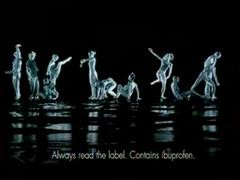Cannes Lions
See My Pain
McCANN, London / NUROFEN / 2024



Overview
Entries
Credits
Overview
Background
Healthcare has a deep-rooted gender problem. Women over-index in ALL types of pain, yet their pain is more likely to be ignored or dismissed by healthcare practitioners. Add to this the fact that almost all pain research is still only done on men, making society’s knowledge of pain in women woefully incomplete, and you’re left with a genuine health crisis for women. It’s known as The Gender Pain Gap.
For Nurofen, a painkiller brand dedicated to “putting people, not pain in charge of life”, this was painful to hear. We set out to tackle the issue. Not just through communications, but through deep organisational and societal change.
Our goal in Yr1 was to raise public awareness of the Gender Pain Gap, in Yr2 we needed to deepen the impact, moving within the system, championing HCPS as allies for change - but being told you’re biased is hard to hear.
Idea
See My Pain. An industry-defining campaign designed to drive positive change by turning Healthcare Professionals (HCPs) into allies, challenging gender bias. We found a shocking 64% of HCPs didn’t believe there was gender bias in healthcare. We needed to convince them, in language they could understand: data and science.
We commissioned a 2nd Gender Pain Gap report, showing the scale of the issue. To make it impossible to ignore, we distributed it direct to 1000s of HCPs inside a provocative range of medical products. Hot water bottles, pills & plasters all featured real dismissals women heard: “It’s in your head”, “just women's issues”.
Placement was key, as well as social, press & tv, we transformed a pharmacy (a symbol of support in communities) into an immersive experience, stocking shelves with our dismissal products, inviting HCPs to walk in women’s shoes and confront the devastating impact of gender bias first hand.
Strategy
Our research showed that women's pain was being dismissed by the very people who should be supporting them, the medical profession.
With our scale as a brand, we knew we could make a genuine difference. We had a network of laboratories across the country, and numerous partnerships with health organisations.
We set out to uncover the biggest barriers to tackling this issue.
Our findings were eye-opening. 64% of HCPs weren't aware of gender bias in pain management.
So how do you convince HCPs to change their behaviour when they're not aware of the problem? And when they don't believe they're biased?
We needed to prove the issue existed, so we commissioned the first ever Gender Pain Gap Report. It revealed that 1 In 2 women's pain has been dismissed. Then we needed HCPs to accept their own bias, so we put them in women's shoes with a provocative new campaign.
Description
2020: From Pills to People:
Facing enormous challenges, we knew we couldn’t do what we’d always done. So in a category driven by rational claims, we chose to break with convention.
Recognising that pain is not just physically but emotionally draining we created a new campaign ‘Leave the pain to us’. This repositioned Nurofen as empathising with the emotional impact of pain on people’s lives.
And sales started to lift.
2022: An issue in need of a megaphone:
We knew we were onto something. So we doubled down on our strategy.
We set out to regain Nurofen’s leadership in pain management, by not only communicating with empathy, but also acting with empathy. But where could we make the biggest impact?
The breakthrough came from a deep understanding of our audience and a discovery that some people’s pain mattered less than others.
Analysis revealed that women experienced more pain, more often than others. They were responsible for 60% of category sales, yet their pain was routinely overlooked, ignored, and dismissed. We spoke to hundreds of women , each with a story that fuelled our outrage.
“My GP told me that most of the symptoms I was describing were ‘irrelevant’”
“They made me feel like I was exaggerating and being dramatic”
“They kept saying, ‘it’s all in your head’’
Women were being gaslit by the people who should be supporting them, the medical profession.
While writers like Emma Cleghorn were highlighting centuries of women’s pain being dismissed, Nurofen could use its scale to help amplify and address this issue.
We set out to establish Nurofen as the leader in women’s pain and propel the “Gender Pain Gap’ into the public consciousness.
A new campaign, ‘See My Pain’:
To succeed in our mission, we needed to make health professionals our allies. Centuries of unconscious gender bias meant that pain was seen as just a normal part of being a woman.
Doctors didn’t even realise they weren’t taking women’s pain seriously.
We also knew, from studying social movements like ‘Me Too’, that we needed compelling language to engage professionals, the press and the public, so we leveraged the phrase ‘The Gender Pain Gap’.
Now to work.
Nurofen invested £3 million in researching The Gender Pain Gap, created the first-ever annual Gender Pain Gap Report, and rolled out gender bias training to pharmacists across the UK.
Fake Products, Real Pain:
To turbocharge the issue into public consciousness we turned real women’s pain dismissals into provocative fake ‘medicinal’ products that exposed the devastating putdowns women receive instead of real diagnoses.
The packs, featured on TV and social media, proved a powerful vehicle for change.
We then created a pop-up pharmacy to get physical ‘dismissal packs’ into the hands of doctors, policymakers, press and the public and turned them into our biggest advocates.
Critically, to support women and their doctors, we created the Pain Pass. A powerful tool, featuring a calendar for tracking pain, language to help women articulate their pain, and tips when facing gender bias.
Execution
See My Pain employed a co-ordinated response with our partners:
1. To validate the issue: we launched the Gender Pain Gap report. It featured the experiences of 10,000 men and women and revealed statistics such as 1-in-6 women experience severe pain every day, but 1-in-2 have been dismissed by healthcare practitioners.
2. To get inside the system: we placed the report inside provocative medicine products each emblazoned with real dismissals women have heard, distributing it to thousands of HCPs. We also created a pop-up Dismissal Pharmacy environment inviting HCPs, press & Policy changemakers to confront gender bias first hand
3. To create real change: we brought women and HCPs together to co-create a free Pain Pass tool designed for both parties to have more constructive conversations around pain - distributed to over 300,000 women in 2,400 surgeries nationwide. Finally, we rolled out bespoke unconscious-bias training in over 10,000 UK pharmacies
Outcome
See My Pain’ is a long-term commitment to close the Gender Pain Gap. In year 1 we un-did our own ingrained biases and set an example for the industry to follow suit.
In year 2, we moved deeper into the system, turning doctors into our biggest allies. We turned women’s dismissals into provocative packs to get our data into doctors’ hands and rolled out UK-wide gender bias training. It worked. They became advocates for change, with 87% of GPs now acknowledging the problem and female pain dismissals dropping by 7%.
Then we created a tool to help women and doctors have better pain conversations and tackle bias together. Over 300,000 were distributed in over 2,300 GP surgeries.
We’ve also increased awareness, with 719+ pieces of earned coverage and a 218% increase in mentions of ‘gender pain gap’ on social. The EU Parliament invited us to share our report in person.
Similar Campaigns
12 items









